Maryborough, in Queensland, is located 220 km north of Brisbane, Australia, on the Mary River. It is a charming town with many wonderful historic buildings.
The Aborignal People
The Aboriginal Butchulla, Gubbi Gubbi and Wakka Wakka people who live around the Maryborough area called the Mary River, Booie Booie, Numabulla, Mooraboocoola or Moonaboola.
Shell middens, stone artefact scatters and numerous scarred trees are areas of Aboriginal spiritual, social and
archaeological significance in the area.
The Butchulla people spoke Badjala, which is believed to be a dialect of Gubbi Gubbi. One dialect of the Gubbi Gubbi language was first recorded by Reverend William Ridley, from notes taken from an interview with James Davis, in 1855. Davis was an escaped convict
who had lived with the Gubbi Gubbi.
A guide to the Gubbi Gubbi
language spoken by the Butchulla people and its grammar can be found
here
Aboriginal people who lived around the Maryborough region moved about according to the seasons. They would travel inland during the colder winter months, and as the weather warmed, they would return back to the coast.
 |
| An Aborignal woman from Maryborough, QLD. An account of four years' travels in Australia and of camp life with the aborigines of Queensland;" (1889) |
The Bunya Pine is an ancient plant from the time of the dinosaurs, which has existed for more than 100 million years.
The name bunya is derived from Aboriginal dialects but the Gubbi Gubbi called the bunya pine "bonyi. The nut was
very important to many Aboriginal clans, and every three years when there was a large crop, many clans would gather to harvest the nuts and engage in ceremonies.
Totems have been an integral part of Aboriginal identity and culture. Plants, animals or parts of the landscape can be totems for Aboriginal Peoples. An example of a Butchulla totem is the Yul’lu (dolphin), which is also known as Boothu and Djamarmee. A dolphin would be a living spirit of an ancestor, for a person with the dolphin totem.
Totems
define a persons role and responsibilities, and relationships with each other.
The Dreaming represents the Aboriginal concept of the time when the land was being created by heroic ancestral beings, with supernatural powers. As the creator beings travelled, they shaped the landscapes, making song-lines.
Wide Bay in the Maryborough region was charted and named by Lieutenant James Cook on 18 May 1770 during his voyage on the Endeavour along the east coast of Australia.
 |
| Australasian (Melbourne, Vic. : 1864 - 1946), Thursday 18 October 1934 |
Andrew Petrie, a Brisbane builder and architect, was commissioned to lead an exploration party to explore the present site of Maryborough in 1842, to report on the economic potential of the bunya-bunya pine and possible grazing land suitable for sheep.
1842 was
also the year that the former penal colony, the Moreton Bay area, became open to free settlement.
During Petrie's exploration of the Maryborough region, the
exploration party encountered a former convict who had lost his ability to speak English beyond saying his name, “Bracewell” ( Wandi). There was another escaped convict living with the Aboriginal people named James Davis. Read more below.
Petrie observed that
the land was suitable for sheep grazing, which led to a Darling Downs overseer named Jolliffe taking up land near Girkum and stocking it with sheep in May of 1842.
By 1847 there were more than 20 license applications for runs in the Wide Bay district.
However, the local Aboriginal people were hostile, and the area was very isolated, which led to settlers and farms being abandoned.
This Original Maryborough Town Site, which was located about four kilometres northwest of the current Maryborough city centre, was occupied between 1848 and 1855, on the south bank of the Mary River.
In July 1847,
the government surveyor, James Charles Burnett, supported the establishment of a port on the Wide Bay River. The river was then renamed he Mary River after Lady Mary Lennox, the wife of Governor Fitzroy.
The First Police Force
In 1848 residents signed a petition expressing the desire for a police force, in the Maryborough area. In January 1850, Chief Constable William McAdam was appointed, with a staff of three constables and one clerk. One of the policemen appointed was John Harwood, a wheelwright from Lancashire, who came to Australia aboard the Artemesia in 1848.
The Harwood family resided at Lennox Street, Maryborough. John became the Mayor of Maryborough in 1868 and Magistrate in 1884.
James Davis (Duramboi)
James Davis (known as Duramboi), probably the first European living around the Maryborough area, was born in Scotland but was transported to Australia for seven years for stealing 2 shillings 6 pence from a church box in Surrey.
After arriving in NSW in August 1825, Davis was sent to the Moreton Bay penal settlement. However, six weeks later, Davis escaped with a companion and they soon joined a group of Aboriginals led by Pamby-Pamby, who believed that James Davis was his dead son returned to life as a white man.
After Davis' companion broke tribal law and was killed (he emptied a number of bones from a native dilly-bag onto the ground believing they
were the remains of some animal. They were human remains). Davis was accepted into the Gubbi Gubbi tribe and was called "Duramboi" (kangaroo rat). He underwent initiation rites and had cicatrices across his chest.
 |
| Aborignal scarification tells about a person's status in the group and their particular identity, Daily Telegraph (Sydney, NSW : 1883 - 1930), Friday 10 September 1926 |
Davis learnt the languages and customs of many different tribes before he was found at Wide Bay in 1842 by Andrew Petrie, who assured Davis that as the convict days were over (finished 1839), he could return to Brisbane without fear of repercussions.
Tom Petrie's Reminiscences of Early Queensland, said of James Davis:
"He was a great man to hunt for game, was always lucky in spearing kangaroo, and he was a good hand at spear and boomerang throwing". |
| James Davis (known as Duramboi) , Courier-Mail (Brisbane, Qld. : 1933 - 1954), Saturday 11 June 1938 |
 |
| Truth (Brisbane, Qld. : 1900 - 1954), Sunday 30 July 1905 |
Settlers and Farms
More settlers began to arrive in 1847, with 20 license applications for sheep runs lodged in the region.
The settlers who established farms severely disrupted the ability of Aboriginal people to carry out traditional hunting/fishing/gathering activities, endangering their survival. This clash
of cultures between land management and traditional practices led to violent confrontations.
Governor Fitzroy then sent surveyor J.C. Burnett to the area, known as Wide Bay, and he gave favourable reports about the land and the potential for a commercial port.
 |
| Pioneering accommodation in Maryborough, circa 1860. Maryborough Wide Bay & Burnett Historical Society |
The Mary River Governor Fitzroy proceeded to name the local river of Maryborough in 1847, after Lady Mary Lennox, his wife, and later, the town drew its name from this source.
The Port of Maryborough was opened in 1847.
George Furber, a publican from Ipswich, set up a wool store, shanty and wharf at Girkum (which had been a remote sheep station belonging to a run occupied by John Eales)
and the first wool was shipped in December 1847.
In 1848, Edgar Aldridge and Richard and Henry Palmer set themselves up in competition to Furber on the opposite side of the river. These entrepreneurs
also established inns, wool stores and a wharf. Later, Maryborough boomed as the port and industrial base for the Queensland goldfields.
Some Aboriginal people were involved in assisting Furber with his ventures. However, one of them hit him with a broad axe on the back of the head and neck. Furber
managed to ride to Ipswich on his horse to be stitched up.
Furber retuned to Maryborough and took his revenge against the Aboriginal man who attacked him, shooting him dead. One year later, Furber and his brother-in-law were killed in the bush when Aboriginal people retaliated. Both sides committed terrible atrocities.
A very complicated and volatile situation was developing with the local Aboriginal people, which involved stolen sheep, revenge, poisoning and the employment of Native Police from southern tribes who viewed the Maryborough Aboriginals as their enemy.
 |
Native Police, Rockhampton, 1864
|
Post Office Established
On 23 January 1849, a post office was established in Maryborough, and the town was officially surveyed and centred to the east of the first settlement.
By 1850 Maryborough was well established as a commercial centre and as a port for shipping wool, hides, timber, and tallow.
Chinese market gardens were located along the banks of Muddy Creek to the east of the settlement.
From the 1850s to the end of the century, the port of Maryborough was one of Australia's busiest immigration ports.
Hugh Roland Labatt, a surveyor appointed by the government, arrived at Maryborough in July 1850, with instructions to select a suitable site for a township.
Maryborough was declared a township in 1851.
The population stood at 299, with 142 being single adult males and 24% of the total being Chinese. The largest occupation group being that of shepherds, stockmen and labourers.
The first circuit court hearings were held in local hotels at Maryborough
from the late 1850s. In about 1856, a permanent court house and lockup were designed for Maryborough, by Alexander Dawson, Colonial Architect of New South Wales.
The settlement was moved downstream a few kilometres in 1856, and this is where the city of Maryborough exists today.
 |
| The remains of the Wide Bay settlement, located about four kilometres from the Maryborough, QLD, city centre, the 30 hectare site has interpretive signage, walkways and trails along the creek frontage, pioneer graves. Renamed Maryborough in January 1849 |
 |
| The remains of the Wide Bay settlement, located about four kilometres from the Maryborough, QLD, city centre, the 30 hectare site has interpretive signage, walkways and trails along the creek frontage, pioneer graves. Renamed Maryborough in January 1849 |
1860s |
| Maryborough, QLD, in 1863, Queensland State Archives |
Immigration
An advertisement in the Wide Bay & Burnett Times on 23 January 1861 by Messrs Melville & Travis declared that they were bringing out British migrants. Another advertisement, by Henry Hamburger, was in support of the emigration of German settlers.
The first migrant ship to land directly at Maryborough was the barque
Ariadne which arrived on 9 October 1862.
During the late 1860s and 1870s, the port at Maryborough expanded,
helped along by gold rushes in the nearby Gympie area.
Among the early migrants to Maryborough, from 1860, there were many German settlers. The first Lutheran pastor arrived in 1864 and a second in 1867.
Between 1860 and 1891, about 180,000 immigrants arrived in Queensland with an assisted government passage and some rights to lease land. Around 16,000 of these migrants were of non-British origin, mainly Germans, Danes, Norwegians and Swedes.
Some Scandinavian surnames of Maryborough's early settlers include: Jocumsen, Claussen, Madsen, Kehlet, Weinberg, Okeden, Boge, Möller.
 |
| Maryborough Chronicle, Wide Bay and Burnett Advertiser (Qld. : 1860 - 1947), Wednesday 7 March 1866 |
 |
| The opening of John Walker's Union Foundry, Maryborough, QLD, in 1868. Maryborough Wide Bay & Burnett Historical Society |
South Sea Islanders
The first South Sea Islander labourers arrived at the port of Maryborough in 1867 on the schooner Mary Smith. All the labourers were male and they were employed by the Maryborough Sugar Company and paid £6 per year and given food and lodging. White labourers received up to £30 a year, but no food or housing.
Many plantations in Queensland used inexpensive imported labour, sometimes
blackbirded (enslaving -often by force and deception) people from islands in the South Pacific. Usually, however, people were employed on three-year contracts, but unscrupulous operators engaged in coercion and deception.The Polynesian Labourer Act 1868 was enacted to regulate recruitment.
The Pacific Islander Hospital and Cemetery site at Tinana
is located approximately 5.5 kilometres (3.4 mi) southwest of Maryborough.
 |
| Australian South Sea Islander cane cutters on a sugar cane plantation in Queensland, 1900, State Library of Queensland |
1870s
 |
| Maryborough Wharf, QLD, 1870, Queensland State Archives |
.jpg) |
| The barque Maria Ysasi, built 1871, in Maryborough, Qld. |
 |
| Maryborough Court House, Queensland, circa 1878 |
1880s
By the 1880s Maryborough
was thriving and many substantial civic and private buildings lined its streets.
The first country telephone exchange was opened at Maryborough in 1882, with 32 subscribers.
Timber mills and an engineering works, established in 1868, called Walker's Limited, provided jobs in the region and contributed to the town's prosperity.
Haunted House?
Edgar Thomas Aldridge built Baddow House in 1883, at 366 Queen Street, Maryborough.
Aldridge married Sarah Slater (nee Steele), a widow and former convict who already had a son. The family lived at Baddow House until the bank foreclosed in 1912.
Edgar Aldridge's son and heir, Harry, and his Aboriginal wife, Lappy (Tanner), had a daughter named Esse, who was said to be so devastated at having to leave the house that she loved, after the foreclosure, that she wiped her tears on the walls. Some say that she
continues to haunt the building's great cedar staircase.
 |
| Baddow House: House belonging to Edgar Thomas Aldridge in Maryborough, QLD, circa 1870 |
Maryborough Base Hospital in Walker Street was built from 1887.
WreckedAn emigrant vessel,
Eastminster, was last seen heading out to sea, departing Maryborough, in a rising gale on 17 February 1888. The ship ignored the warning from the harbour pilot, and a tropical cyclone passed
through the area soon after. Wreckage from the ship was seen on a coral reef east of Rockhampton.
 |
| Eastminster (ship). Eastminster in the late 1880s, at Walker’s Wharf, Mary River, Maryborough Queensland. "Wreck in 1888". Eastminster. Master, W. Mosey. 1145 tons. Iron ship, built in Port Glasgow |
 |
| St. Mary's Catholic Church in Maryborough, QLD, 1880, State Library of Queensland |
1890s
 |
Central State School, Maryborough, c 1890, Maryborough Central State Girls School had its origins in the mixed Maryborough State School which opened in 1862. About 1874, the boys and the girls were separated into two schools, the boys' school becoming Maryborough Central State Boys' School and the girls and infants combining to become Maryborough Central State Girls' and Infants' School . The new school acquired the number 249.
On 15 December 1877, the combined girls' and infants' school closed and was replaced by separate schools for infants and girls. The new Maryborough Central State Girls' School opened 21 January 1878 and retained the school number of 249.
On 29 July 1932, the Maryborough Central Boys' School and the Maryborough Central Girls' School both closed and the boys and girls once again joined to become the Maryborough Central State School. Queensland State Archives |
 |
| Court House, Maryborough, QLD. The Maryborough Court House was constructed in 1877 to the design of the then Colonial Architect, FDG Stanley for use as both a court house and government office block. The building is the second Maryborough Court House replacing an earlier 1860s building constructed on another site. Queensland State Archives |
In the afternoon of 7th June, 1890, at Maryborough, Miss Gladdy Van Tassell made a balloon ascent and parachute jump, landing near the Hospital in Walker Street.
 |
| Maryborough Chronicle, Wide Bay and Burnett Advertiser (Qld. : 1860 - 1947), Friday 6 June 1890 |
 |
| Maryborough Bridge under construction, QLD, 1896, Queensland State Archives |
 |
| Flour Mill in the Wide Bay and Burnett District situated on the railway line, approaching the Maryborough railway station, QLD, Gympie Times and Mary River Mining Gazette (Qld. : 1868 - 1919), Saturday 23 December 1899
|
1900s
The Aboriginals Protection and Restriction of the Sale of Opium Act 1897 (Qld) gave the Chief Protector of Aboriginal people a large amount of power over Aboriginal lives.
In Maryborough and surrounding areas, many Aboriginal people were relocated to a mission station at White Cliffs, on the western side of Fraser Island. This station was soon moved further north to Bogimbah Creek.
 |
| "Alreena" - Fraser Island Aboriginal Girl - very early 1900s, Aussie~mobs |
 |
| "School of Arts in Kent Street, Maryborough, Qld - very early 1900s", Aussie~mobs. Maryborough School of Arts at 427 Kent Street, Maryborough, Queensland, was designed by John Harry Grainger and built from 1887 to 1888 by Jacob & John Rooney |
 |
| Wharves in Maryborough, Queensland - circa 1900, Aussie~mobs |
 |
| Queensland National Bank in Maryborough, QLD, Originally owned and occupied by Toward, Bryant & Co. (1860s) and then demolished ca. 1914 for the new bank building. State Library of Queensland |
 |
| Adelaide Street, Maryborough, QLD, circa 1900. |
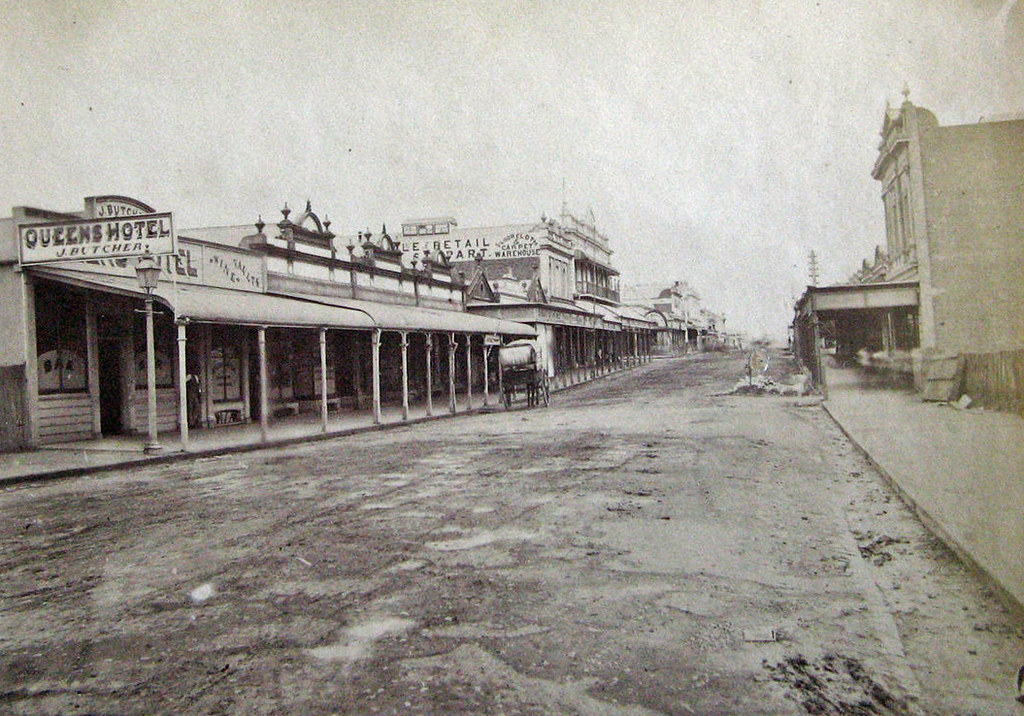 |
| Maryborough, Queensland - circa 1900. Kaye |
 |
| Shipbuilding in Maryborough, Qld - early 1900s, Aussie~mobs |
 |
Family of sisters (nee Brennan) who all married into the Steindl family. At top left is Gertrude Steindl, who married Lee Steindl of Maryborough in 1905. At bottom left is Nellie Steindl, and one of the other sisters is Winnie Steindl (Description supplied with photograph). State Library of Queensland
|
 |
| Portrait of Mrs. Gertrude Steindl and baby, ca.1900, Portrait of Mrs. Gertrude Steindl (nee Brennan), wife of Lee Steindl, and baby. Mrs. Steindl is wearing an embroidered blouse and a hat swathed in fabric. Baby is wearing a dress and bonnet. Photograph taken by Olesen and Strong of Maryborough. State Library of Queensland |
 |
| Public schools in Maryborough, Qld - early 1900s, Aussie~mobs |
Plague
An outbreak of pneumonic plague occurred in Maryborough in 1905, after a freighter from Hong Kong docked into the port of Maryborough.
 |
| Photo of Dr Burnett Ham and his Medical and Nursing staff, Maryborough, QLD, June 1905, Queensland State Archives |
 |
| Gympie Times and Mary River Mining Gazette (Qld. : 1868 - 1919), Thursday 8 June 1905 |
 |
| Bazaar Street, Maryborough, Qld - circa 1905, Aussie~mobs |
 |
| General Hospital, Maryborough, Queensland, ca. 1906, State Library of Queensland |
 |
| Lawn bowls, Maryborough, QLD, ca. 1907, State Library of Queensland |
 |
| Finney Isles and Co in Maryborough, Qld - 1908, Aussie~mobs |
 |
| QPSR Australian 1908 steam train number 448 class PB15. Built by Walkers Limited of Maryborough, QLD (builder's number 93 of 1908) (c) as one of the very successful PB15 class of locomotives. Lance CASTLE |
 |
| Gunboat HMAS Paluma, Maryborough Wharf, QLD, 1908. HMQS Paluma was a flat-iron gunboat operated by the Queensland Maritime Defence Force and later the Royal Australian Navy as HMAS Paluma. She entered service on 28 October 1884, decommissioned in 1916 and then sold to the Victorian Ports and Harbours Department, who operated her under the name Rip until 1948 when she was retired. She was scrapped in 1950–51. Queensland State Archives |
 |
| Mary River showing the City Beach, Maryborough, QLD, Week (Brisbane, Qld. : 1876 - 1934), Friday 3 June 1910 |
 |
| Wharf St and Mary River, from the Post Office, Maryborough QLD, Week (Brisbane, Qld. : 1876 - 1934), Friday 21 January 1910 |
 |
| The boilermakers at Walkers LTD, Maryborough, QLD, Brisbane Courier (Qld. : 1864 - 1933), Saturday 22 July 1911 |
 |
| Ambulance Maryborough, QLD, Week (Brisbane, Qld. : 1876 - 1934), Friday 16 December 1910 |
 |
| Maryborough QLD, lady cricketers, Brisbane Courier (Qld. : 1864 - 1933), Saturday 19 July 1913, |
 |
| Bungalow Theatre on Kent Street Maryborough, Queensland, circa 1914 |
WWI
 |
| Lieutenant (later Major) Duncan Chapman, the first man to step ashore at what was to become Anzac Cove. A bronze statue of Chapman can be found in Maryborough’s Queens Park, QLD, as Maryborough was his home town. Telegraph (Brisbane, Qld. : 1872 - 1947), Wednesday 29 November 1933, |
 |
| Thomas William Glasgow was born on 6 June 1876 at Tiaro, near Maryborough, Queensland and attended Maryborough Grammar School. He was a senior Australian Army officer and politician. Glasgow rose to prominence during the First World War as a brigade and later divisional commander on the Western Front. Glasgow joined the Wide Bay Regiment of the Queensland Mounted Infantry in 1893. Australasian (Melbourne, Vic. : 1864 - 1946), Saturday 17 June 1944 |
 |
| Edward Corser was a co-founder and president of the Maryborough Chamber of Commerce, Seated (left to right) : Mr. E. B. C. Corser (M.H.R. for Wide Bay), Mr B. H. Corser, M.L.A. (Burnett), Mrs. E. B. C. Corser.Standing (left to right) : Mr. E. S. Corser (president Maryborough Chamber of Commerce and managing director Messrs. Corser and Co., Ltd.), Sergeant H. E. Corser (at Enoggera Camp), Miss Muriel Corser, Captain C. F. Corser, 15th Battalion (returned wounded from Gallipoli), and Mr. Sidney C. Corser (agriculturist, Biggenden). We need scarcely inform our readers that the Corser family is one of the best known Catholic families in Queensland, as their work in connection with Catholic affairs in the Maryboroughdistrict is well known. Milne photo.Catholic Advocate (Brisbane, Qld. : 1911 - 1919; 1923 - 1934; 1936 - 1938), Thursday 27 January 1916 |
 |
| Brisbane Courier (Qld. : 1864 - 1933), Saturday 12 June 1915 |
1920s
 |
| THE PRINCE OF WALES IN QUEENSLAND. VISIT TO MARYBOROUGH, TIARO, AND GYMPIE ON AUGUST 9. 1. LEAVING THE GYMPIE RAILWAY STATION. 2. ABORIGINAL ARCH IN LENNOX STREET, MAKYBOROUGH. 3. THE PRINCE LISTENING TO THE ADDRESS OF WELCOME AT GYMPIE. 4. THW "DIGGERS" ARCH IN KENT STREET, MARYBOROUGH. Australasian (Melbourne, Vic. : 1864 - 1946), Saturday 14 August 1920 |
 |
Launching the cargo steamship Echuca at Walker's Shipyard in Maryborough, Queensland
Date 1921, SLQLD |
 |
| Cane punts on the Mary River, Maryborough, QLD, Sydney Mail (NSW : 1912 - 1938), Wednesday 5 November 1924 |
 |
| Loading the cane in the Maryborough region, QLD, Sydney Mail (NSW : 1912 - 1938), Wednesday 5 November 1924 |
 |
Tarrant Cycle Shop, Kent Street, Maryborough QLD, circa 1926
|
 |
| Sydney Mail (NSW : 1912 - 1938), Wednesday 17 October 1928 |
1930s |
| The first aerial pageant at Maryborough Airport, QLD, was held Saturday, 7th June, 1930, organised by Charlie Hillman and K. McDonnell who stated that "an aero club in Maryborough seems now well within the bounds of possibility".Queenslander (Brisbane, Qld. : 1866 - 1939), Thursday 19 June 1930 |
 |
| James Herbert Bayley 29, William Edward Bayley 23 and Henry Walter George Bayley 32 died of strychnine poisoning after eating scones at a Fisherman Hut. Truth (Brisbane, Qld. : 1900 - 1954), Sunday 13 March 1932 |
 |
| Maryborough, QLD, looking from the Post office tower, circa 1934. Qld State Archives |
1
 |
| Maryborough Chronicle, Wide Bay and Burnett Advertiser (Qld. : 1860 - 1947), Tuesday 23 April 1935 |
 |
| Maryborough Chronicle, Wide Bay and Burnett Advertiser (Qld. : 1860 - 1947), Saturday 12 September 1936 |
1940s and WWII
One air raid shelter survives of two built in the early 1940s, south-west of the Maryborough railway station building.
As part of the Empire Air Training Scheme (EATS) Maryborough, was chosen as a base for a Wireless Air Gunner School (3 WAGS) and an Air Navigation School (3 ANS). Heritage air force base buildings still exist at Saltwater Creek Road, Maryborough, QLD.
 |
| Maryborough, QLD, men pose for a photograph outside one of the huts at Fraser's Paddock, Ashgrove, where they are encamped with other members of the 47th Battalion, who are undergoing three months' military training.Telegraph (Brisbane, Qld. : 1872 - 1947), Saturday 10 February 1940 |
 |
| Maryborough Chronicle, Wide Bay and Burnett Advertiser (Qld. : 1860 - 1947), Wednesday 14 May 1941 |
 |
| Maryborough Qld nursing staff, Weekly Times (Melbourne, Vic. : 1869 - 1954), Saturday 14 June 1941 |
 |
| Weekly Times (Melbourne, Vic. : 1869 - 1954), Saturday 14 June 1941 |
 |
A.C..W. Hazel Mischlistki Australian - born of Russian parents, A.C.W. Mischliwski comes from the Maryborough district, QLD. She, too, was a keen horsewoman before Air Force days. WAAF, Sunday Mail (Brisbane, Qld. : 1926 - 1954), Sunday 18 April 1943 |
 |
| The Battle of Balikpapan was the concluding stage of Operation Oboe, the campaign to liberate Japanese-held British and Dutch Borneo. Northern Star (Lismore, NSW : 1876 - 1954), Monday 27 August 1945 | |
 |
| Sister Jean Stewart, daughter of the late Mr. Charles Stewart, Maryborough, massacred by Japs on Banka Island. Courier-Mail (Brisbane, Qld. : 1933 - 1954), Friday 12 July 1946, |
 |
|
Elliott (Elley) Bennett (1924-1981), boxer, was raised at Barambah
(later Cherbourg) Aboriginal Settlement, near Murgon, and at
Mary-borough, where he attended primary school. Bennett’ had an
eight-year career as a professional boxer, Sporting Globe (Melbourne,
Vic. : 1922 - 1954), Wednesday 28 April 1948 |
 |
| SPENDING
a sunny afternoon on the golf links at Maryborough were, from left:
Miss Margot Ferris, Mrs. Marjorie Knowles, ond Mrs. Mollie Brain.
Brisbane Telegraph (Qld. : 1948 - 1954), Sunday 21 August 1949 |
1950s
 |
| Adelaide Street, Maryborough, Qld - circa 1950, Aussie~mobs |
 |
| Aubinville, is north-west of the Maryborough city centre, QLD, Maryborough Chronicle (Qld. : 1947 - 1954), Wednesday 16 August 1950 |
 |
| HRH Princess Alexandra of Kent visited Maryborough, QLD, in 1959 for Queensland's centenary celebrations. Queensland State Archives |
1960s
 |
| "Arkana Motel in Maryborough, Qld - April 1963" by Aussie~mobs |
1970s
 |
| Maryborough City, Maryborough, QLD - Cooloola (1970s) Queensland State Archives |
Mary Poppins
The then-Australian Joint Stock Bank at Maryborough was the birthplace of PL Travers, the creator of Mary Poppins. Born Helen Lyndon Goff in 1899, Ms Travers's father, Travers Goff, was the bank manager of the then-Australian Joint Stock Bank, and the family lived upstairs, over the bank.
 Around Maryborough
Around Maryborough
 |
| The Maryborough Heritage Centre, QLD, (formerly Bank of NSW) was built in 1877 |
 |
| View of Mortuary Chapel in the Maryborough Monumental Cemetery, Queensland, built from 1883 to 1884 |
%2C_view_from_Albert_Street.jpg) |
| Albert State School, Maryborough, QLD, circa 1883 |
_(1997).jpg) |
| Australian Joint Stock Bank Building, circa 1882, Maryborough, QLD |
.jpg) |
| Brennan & Geraghtys Store & two adjacent buildings and stables, circa 1871, Maryborough, QLD |
 |
| Criterion Hotel, Maryborough, built from 1878 to 1883 by the Cooper Brothers, Maryborough, QLD |
_(1995).jpg) |
| The former Engineers' Arms Hotel in Maryborough was constructed in 1889, Maryborough, QLD |
 |
| Gataker's Warehouse Complex was built in 1879, Maryborough, QLD |
 |
| Maryborough Courthouse was built in 1877, Maryborough, QLD |
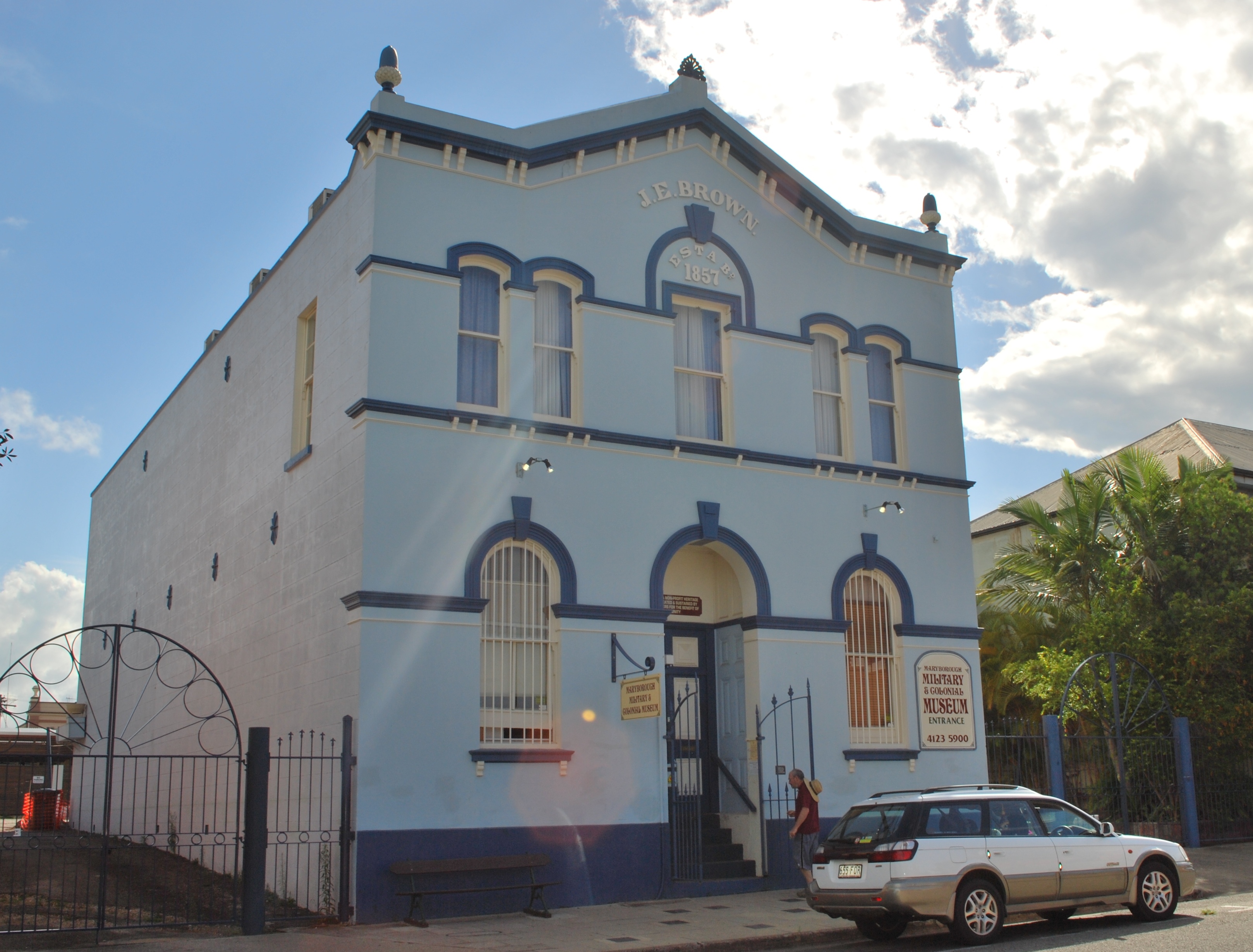 |
| The Maryborough Military & Colonial Museum, founded 1879, Maryborough, QLD |
.jpg) |
| Oonooraba was built about 1892, Maryborough, QLD |
 |
| Former Queensland National Bank built from 1914 to 1915, Maryborough, QLD |
 |
| The former Hotel Francis was built in stages between 1878 and 1938, Maryborough, QLD |
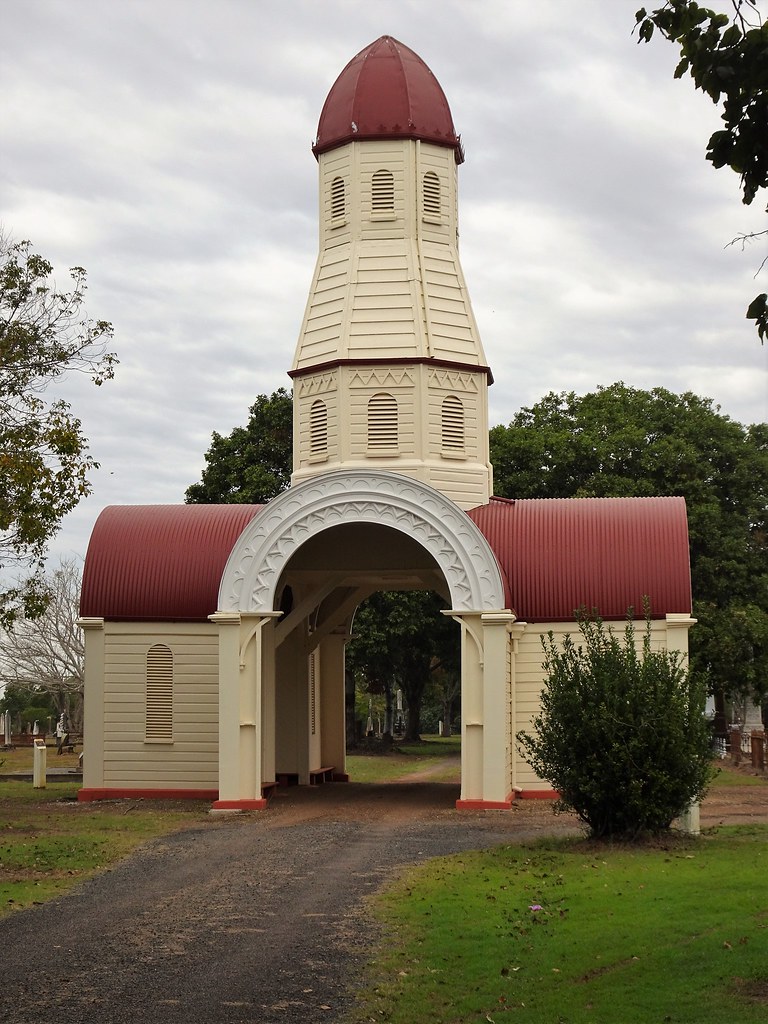 |
| Another view of the mortuary chapel where horse-drawn hearses stopped to unload coffins. Built in 1883 and restored in 1983 Denisbin, Maryborough, QLD |
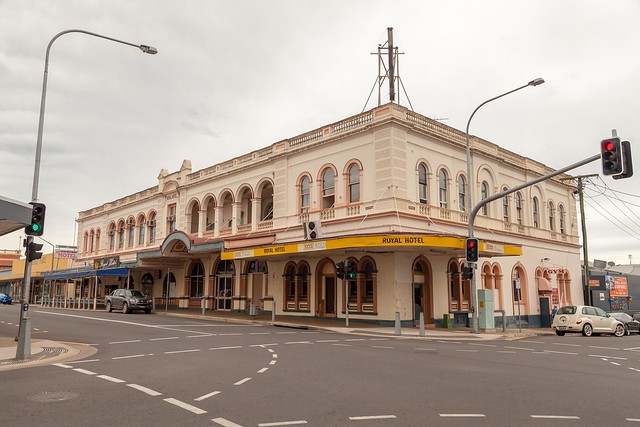 |
| Maryborough - Royal Hotel 1902 Around Oz, Maryborough, QLD |
 |
| The heritage listed Maryborough Railway Station features a Victorian design. Built in 1882, Maryborough, QLD |
 |
| Rosehill was built at Maryborough, Queensland, in 1858 for John & Mary Ann Eaton, Maryborough, QLD |
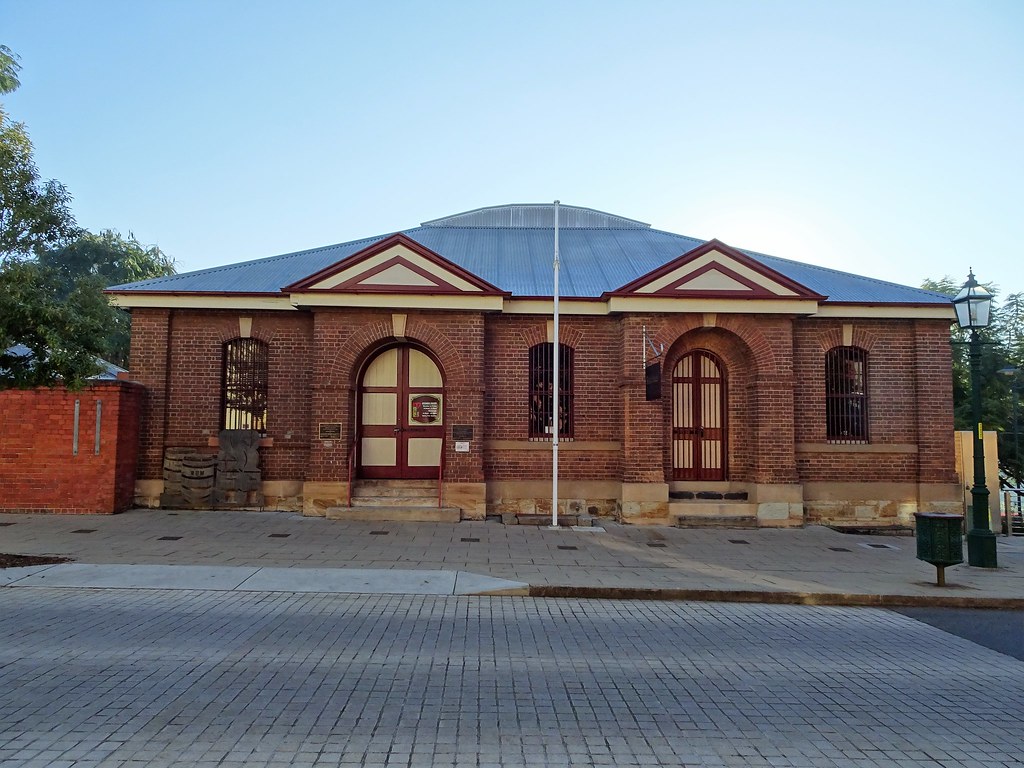 |
| The Wharf Street frontage of the old Bond Store. Built in stages beginning in 1868, extended in 1870 and again in 1883. Now a museum. Denisbin, Maryborough, QLD |
 |
| Maryborough Post Office, built in 1865-1866, Maryborough, QLD |
.jpg) |
| Ilfracombe at Lennox Street, Maryborough, was built from c. 1893 to c. 1895, Maryborough, QLD |
.jpg) |
| Eskdale was constructed in about 1864 for the Mayor of Maryborough, James Dowzer, Maryborough, QLD |
 |
| Maryborough Government Offices Building, built in 1940 by relief work, Maryborough, QLD |
 |
| Maryborough. Wharf Street. Old advertising and the wooden building is the Waterside Workers Building erected during the international watersie workers' strikes of 1918. Denisbin, Maryborough, QLD |
 |
| Kent Street, historic buildings, Maryborough, QLD |
 |
| Classic Queenslander, Maryborough, Queensland. Today, many heritage buildings survive in Maryborough. Including, many fine examples of the elevated Queenslander house, a housing style which was often referred to as "High-set". |
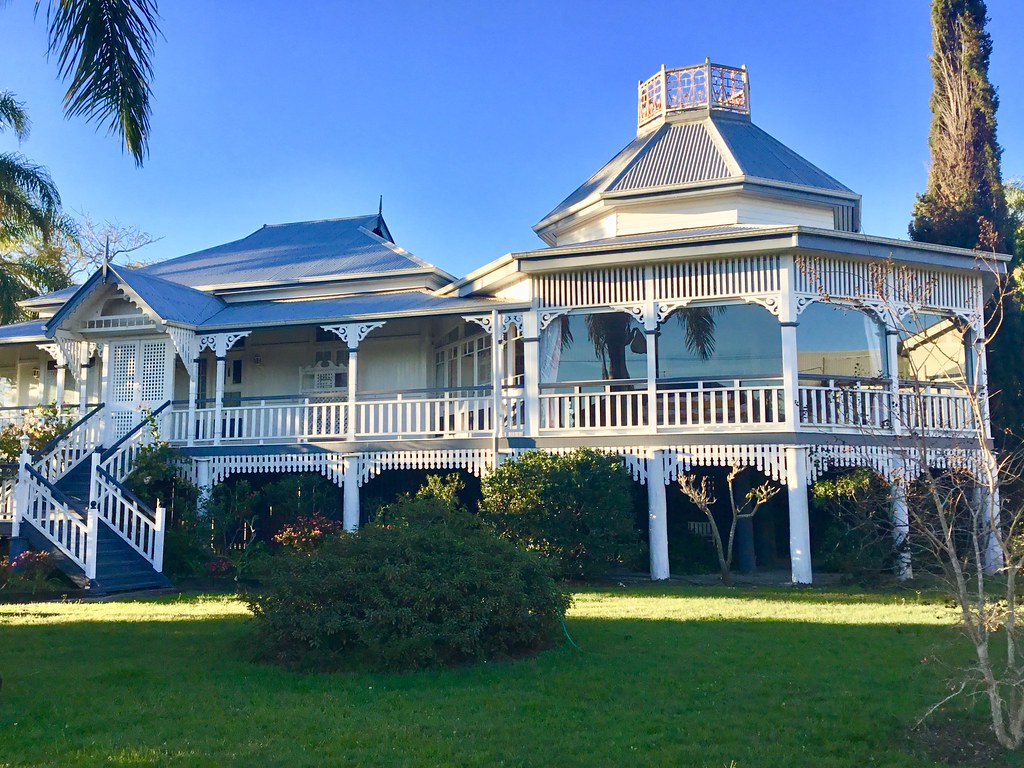 |
| House built between 1910 and 1912 for a local dentist Harry Watson. A later owner added the octagonal room and turret. A grand wooden Queenslander house on stilts. Denisbin, Maryborough, QLD |
 |
| The Maryborough Flour Mill was the most northerly flour mill in Australia when it was built in 1890, for the Maryborough Milling Company, Maryborough, QLD |
 |
| The Maryborough QLD, military museum was originally a warehouse operated by J.E. Brown. The building was constructed in 1879 but the firm was established in 1857 |
 |
| The story of the Kanaka South sea Islander memorial, Maryborough. Denisbin |
 |
| Kings café next door to Stellmachs at 211 Adelaide St, Maryborough, QLD. A superb Art Deco building. King’s Cafe was constructed in 1914 for King Bros, who were connected with the fish and oyster trade. King Bros was formed by Mat King. King’s business was so brisk that the earlier building could not cope, hence the remodelling of it in an art deco design in 1938. King’s cafe operated until 1972. denisbin |
 |
| Original Maryborough QLD, site |
 |
William McAdam BIRTH 1790 DEATH 19 Mar 1860 (aged 69–70)
Maryborough, Fraser Coast Region, Queensland, AustraliaBURIAL Maryborough Pioneer Cemetery Maryborough, Fraser Coast Region, Queensland, Australia
MEMORIAL ID 145953182 |
 |
Baddow House, Maryborough QLD, was built in 1883 by Edgar Thomas Aldridge
|
Things To Do and Places To Go
Free Guided Maryborough Heritage Walk Tour













.jpg)













































%2C_view_from_Albert_Street.jpg)
_(1997).jpg)
.jpg)
_(1995).jpg)

.jpg)




.jpg)
.jpg)




































